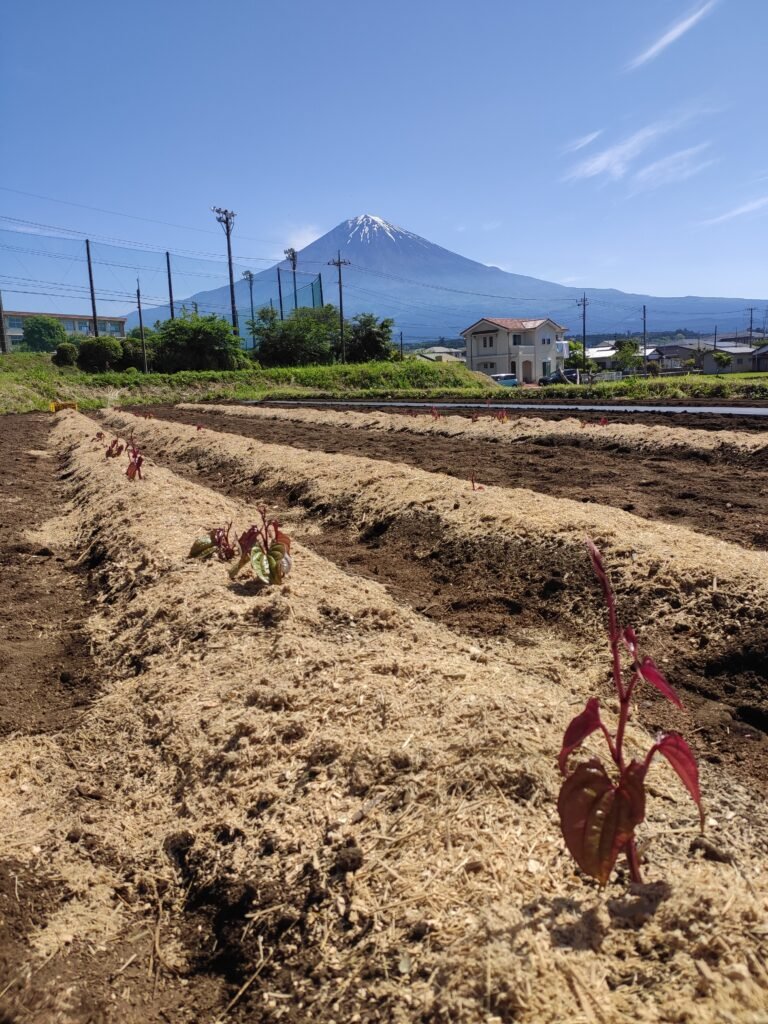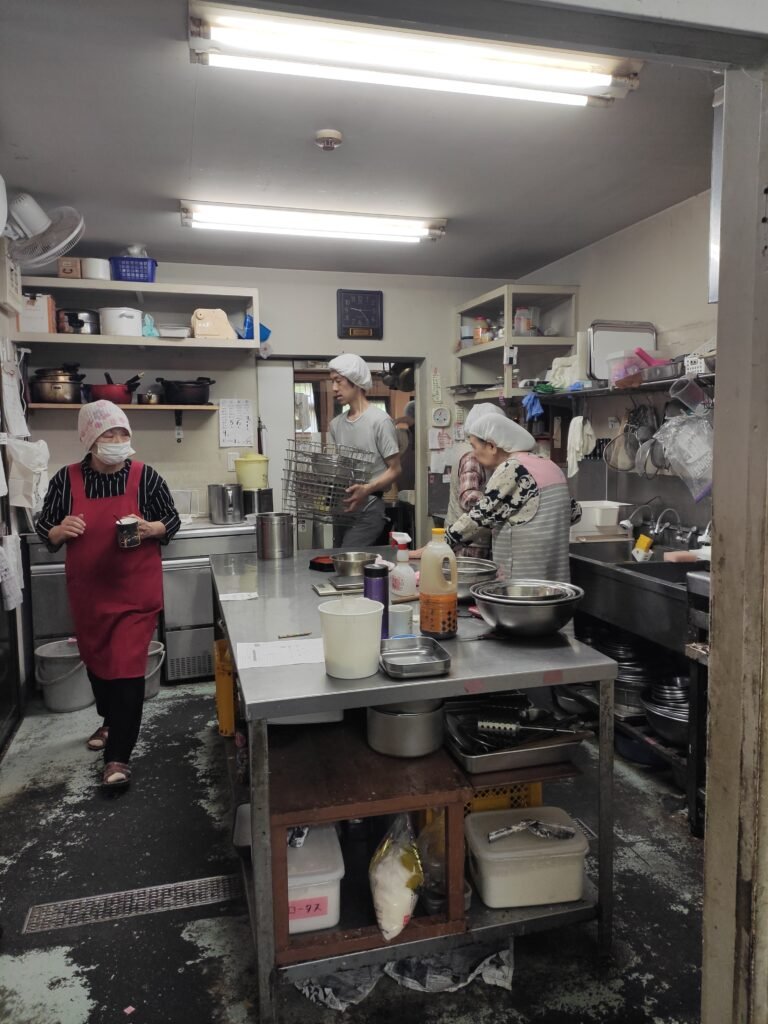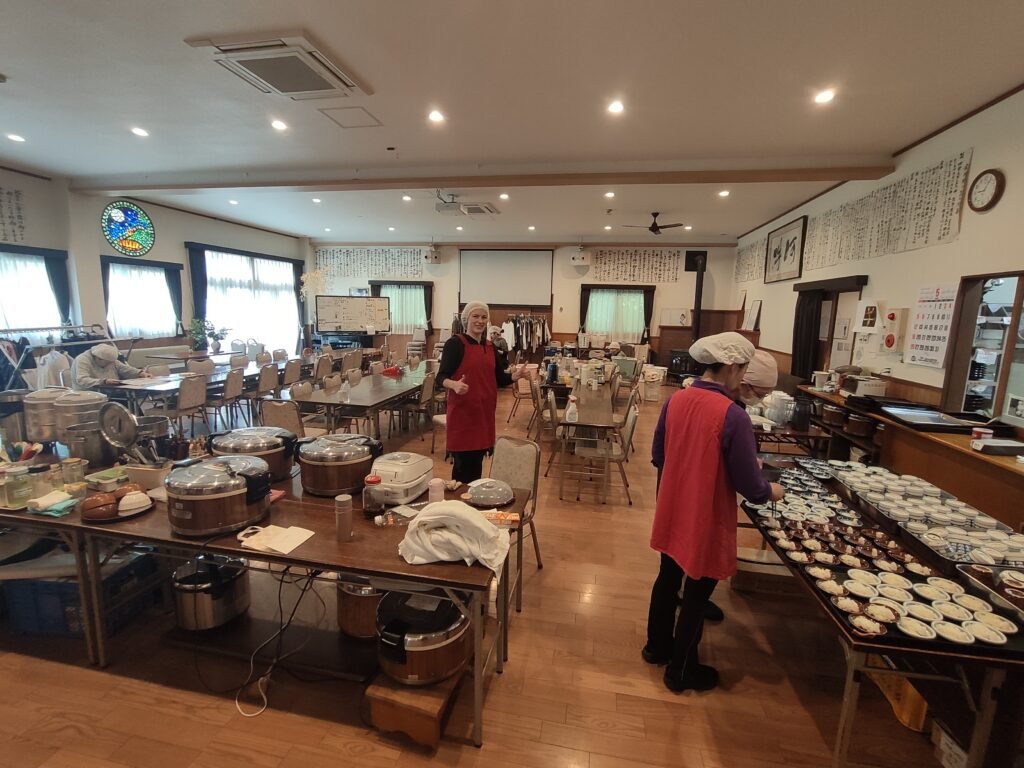Last updated on Juli 15th, 2024 at 05:17 a.m.
Back in Japan we had the pleasure of staying with Konohana Family for 5 days. This eco-village was founded about 30 years ago and still thrives with almost 100 members. Located in Fujinomiya, you get to witness the most amazing views on Mt. Fuji directly from their fields, all while experiencing the unique lifestyle of the Japanese countryside. But what is an ecovillage and what makes the Konohana Family one? How do they live? And what could we experience during our short stay there?
What is an ecovillage?
“An ecovillage is an intentional or traditional community that is consciously designed through locally owned, participatory processes to regenerate social and natural environments.” (Definition and membership criteria 2012 of intern. board of Global Ecovillage Network (GEN, founded in 1995))
So, if you break it down a bit, it is basically a group of people living together with the goal to regenerate nature, mostly via sustainable farming, but also through other projects. At the same time members support each other and thus create a healthy community, pulling on the same strings and helping each other in times of need.
I will soon (or at some point between tomorrow and in 2 months) upload another post more specifically about ecovillages, so stay tuned!
What is Konohana Family?
As mentioned before, Konohana Family is a community with almost 100 members of all ages. While their main focus is on Fujinomiya, they have a second home further up in the mountains, which allows them to grow a wider variety of fruits and vegetables. They practice sustainable, herbicide and pesticide free farming, using mainly manpower instead of heavy machinery. But, additionally to farming, they have a wide range of skills and thus allow members to focus on what they are good at. In our limited time there we did not get to see everything they do, but here is some of it: farming, bee-keeping, running a bakery, 2 cafes and a shop, producing soy products such as soymilk, tofu and soy sauce, making their own miso, offering natural therapy programs, a band and choir, special events such as a homemade Soba restaurant (once a month – we had the pleasure to be there!) and probably many more things, that I simply forgot about by now. But you get the picture – this is a community that could practically function on its own. Instead of withdrawing from society though, they are open to it and cherish a lot of exchange with their neighbours, while carrying their message out to the world.
In contrast to many other ecovillages, Konohana Family was formed out of a strong faith though and many of their practices evolve around accepting what life gives you. Every member does their task to help the whole village to function and they all work together, towards the same goal of living in harmony. In that way, they are very similar to a beehive, with lots of busy worker bees gathering food and protecting each other. Their children are raised by the housekeepers rather than the biological parents, but more about that later. The question is – is there a queen to this hive? Well, kind of yes but also no. The original founder is still living there and gives a lot of guidance, especially on spiritual themes or personal development. But he is still working like the others, ironically, he is responsible for beekeeping, so in a way he is just another working bee, doing his job.






How does Konohana Family do…
1. Farming
As this ecovillage evolved and grew naturally rather than being planned, it is quite spread out throughout the village and neighbourhood. There are multiple fields, glass houses and even lotus ponds they attend to and many of them aren’t even owned by them. Due to urbanization and ageing in the Japanese population, many local farmers can’t attend to their fields by themselves anymore and don’t have children (willing) to follow in their footsteps. Some of them asked the community to look after their fields, and so they grew without buying any land. This also means though, that it is necessary to drive between the different standpoints, for which they own multiple cars they share as needed.
Their methods in farming are organic, using permaculture principles and ever-evolving in cooperation with researchers. While more sustainable than most farming, they still use lots of plastic, which is something I personally am not very fond of. However, they achieve amazing results and produce high quality and quantity of foods.
In farming they have different teams working – they are separate teams for fruits, vegetables, planting and harvest. As with all jobs it is common for people to switch as necessary, so when one team gets to busy, they get supported by others. We had the opportunity to work in vegetable planting and harvesting. As we were there in May, we were planting marigold as a companion, , preparing some fields, doing weeding and harvesting (gigantic) onions.






2. Child raising
Children born into Konohana Family are raised by the community as a collective. There is a team of housekeepers, who look after the children during the day, while also doing laundry and some cleaning etc. The biological parents are in no way special to the children – they even call each other by their first name. All adults get a chance to bond with the children and help raising them when needed. So, from the child’s perspective there truly is a whole village looking after them and there will always be someone who can meet their needs. They live together in a house with the housekeepers and spend most of their time in the main hall, playing, learning, etc. Once they are old enough, they attend school as everyone else in Japan and later on can choose to go for a higher education or learn something within the community.
As someone from Europe, it is very hard for me to imagine letting go my (hypothetical future) children that fully and not have a more special bond with them. However, it seems to me that raising them within a community rather than persisting on having a small “core family” is a lot more natural and easier for the mothers. This weird tendency to isolate and insist on a mother to stay at home alone with her children creates unnecessary pressure and loneliness. There is a reason we say it takes a village…


3. Community gatherings, decision making and conflict resolution
Every evening after dinner there are two meetings: first the children meet and get a chance to share what they did or learned that day. They can get advice if needed and practice public speaking in a very natural manner from an early age, which leads to them feeling more at ease doing presentations in school and later on as well. After that, they go to bed and the main hall is cleaned collectively, which only takes about 10 minutes. Then the adults have their meeting. This is live screened to the community members living in other places, so truly everyone is connected during this time. In the meetings they discuss practical things as well as spiritual concepts or philosophical questions. Everyone can share their thoughts and be heard. When they have to make a decision, everyone tries to see the problem from a higher point, put aside their ego and think about what is best for the group as a collective rather than themselves. In this way, they avoid conflicts and usually reach the same conclusions. Their motto of accepting what life gives them surely helps with this as well.
I cannot say that I fully understand, how they manage to function so well as a group and always agree on everything, but putting aside one’s ego when making decisions for a group surely sounds like a noble goal worth striving towards.
4. Baths
Now, you might think, why do baths get their own section. Well, because they’re special of course. As some of you might know, Onsen, or hot baths/springs, are a big thing in Japan. Many hotels have a private one for their guests and it is completely normal and most of the time required to go in naked.
Keeping that cultural background in mind, here is what Konohana Family does: every day there is a time window in the late afternoon for everyone to bathe. First, women and children get about 1 ½ hrs, then man get 1hr (before you complain, there is a lot more women and also, have you tried bathing a child? No? Then shut up). Of course there are some other bathrooms, mainly for people working longer and thus not making it to those times but let’s stick to the main event. They share a bathroom with four showerheads and a big bathtub. When you come in, you will first wash yourself thoroughly at one of the showerheads. This is usually done sitting on a small stool. They have soap, which they use for everything, including washing your hair and giving your clothes (mainly underwear) a rinse before dropping it of for laundry. To neutralize the soaps effect on the hair, they use apple vinegar, which truly works wonders, my hair has not been that soft in a long time. Once you are clean, you can hop into the bathtub. It easily fits four adults and is set to 43°C, so its more like going into a hot spring. After steaming for a while, you rinse off at a shower again and go back out to dry off, do your hair and get dressed.
This whole time is a great chance for people to catch up, so rather than trying to avoid each other and be done quickly, people chat and talk about their day during these baths, which makes it a very social experience. This might not be for everyone, but I quite like it. Not only does it save water and electricity, it also de-stigmatises naked bodies and normalizes just being who you are. We can just talk to each other and interact normally, all while being naked, because a naked body is not something wrong or disgusting or inherently sexual. Also, we can see other people naked and not stare or comment at all. In my eyes, this is a very peaceful state of being.



5. Soba
This special kind of noodles is made from buckwheat, which Konohana Family grows itself. They have their own Soba chef, who makes the noodles from scratch and then the whole kitchen comes together and prepares sauces and side dishes for this event. We were incredibly lucky to be there during this time and help in the kitchen when preparing. They are highly professional and efficient and when we tried the food, it was incredibly good.
This event happens once a month and they use the rooms normally reserved for guests to open a restaurant. There were a lot of people coming, so all tables were full within minutes of opening, and they even have a waiting area – quite incredible considering they are located in the countryside. So, people look forward to this event and specifically make plans to go there, which says a lot about the quality of the food.




6. Music
As I mentioned in the beginning, Konohana Family has its own band and a choir. The band writes its own songs and even records them, most have a deeper meaning of spiritual background. Both the band and the choir come together to sweeten any festivities they might hold, parties, or when welcoming visitors and they perform for their guests and each other. For some songs they even have dancers, and the children also have their own song they can perform.
We had the chance to see them during our welcoming concert, which they do for all new visitors and is a beautiful and quite touching start into the time you have there. Sometimes, they will also sing fitting songs during the meetings together, using music as a way to express emotions and bond with each other.
7. Visitors
Just like we did, it is possible for everyone to visit Konohana Family, if they wish to do so. They have a natural therapy program, which combines an introduction to their spiritual belief system, massages and work in the community to help through psychological ailments by giving purpose and support. But you can also come as someone curious about their way of life and help out about 5hrs a day, just as we did. For this you pay around 30€/night, for accommodation and food and you can choose which type of work you want to do. If you want to be there as a volunteer, you will not have to pay, but work about 8hrs a day and do whatever they need, rather than picking your favourite type of work and spending the time there.
If you want to learn more about staying at Konohana Family, you can check out their website and this video on YouTube.



Finally, I’d like to say that during our whole stay we were treated like members of the family and felt very welcome and at home, so I can wholeheartedly recommend going there and experiencing a different way of life first-hand. It was a true pleasure to take this deep-dive not only into living in a community, but also into Japanese culture, which can otherwise be rather hard for foreigners who don’t speak the language. We learnt a lot and I personally quite enjoy being challenged in my worldview and re-thinking what is and is not normal and why things can’t be different. Thank you.
What do you think about live at Konohana Family? Is this something you can imagine and would even like to try or is it so foreign to you, that you’d rather stay away from it? Let us know in the comments below!
xxx